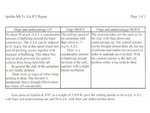- Thread starter
- #41
DAVIDICUS said:I recall that the USAAF tested the FW-190 against the P-47 in 1943 and one of the noted characteristics of the Fw-190 was its extremely bad high speed stall that was particularly dangerous because the aircraft exhibited no advance warning.
The P-47's wing shape may have had something to do with its ability to transmit an advanced warning.
The relevance here, if any, is that the P-47's wing shape was closer to the Spitfires whereas the FW-190's was closer to the ME-109's.
A Fw-190 doesnt have slats

